Calculated Anatomy Knowledge in Wolfram Language

Translation of the Keiko Hirayama post " Dissecting the New Anatomy Content in the Wolfram Language ".
The code given in the article can be downloaded here .
Many thanks to Kirill Guzenko KirillGuzenko for his help in translating and preparing the publication.
The human body is the subject of study from the very beginning of human history. Modern scientific trends in anatomy and physiology derive from the symbiosis of art and anatomy that arose during the Renaissance. At the beginning of the 16th century, Leonardo da Vinci was one of the first to present fairly detailed and accurate sketches of the human body and its structures. In 1543, Vesalius published the famous textbook De Humani Corporis Fabrica (On the Structure of the Human Body) with beautiful illustrations thereof.
')
With modern technology at our disposal, we can present data on physiology and anatomy in a computable format. With the help of Wolfram | Alpha, we have created for all the opportunity to easily study how individual anatomical structures are connected with each other in the human body, as well as to investigate both whole organ systems and their microscopic components.

Let's begin our research with macroscopic structures.
From an important organ of the cardiovascular system - the heart:

Wolfram | Alpha provides not only basic information about the anatomical structure (Latin name, function, group, parts, etc.), but also calculates the relationships and connections between the anatomical structures.
Here, for example, the arteries supplying blood to the heart :
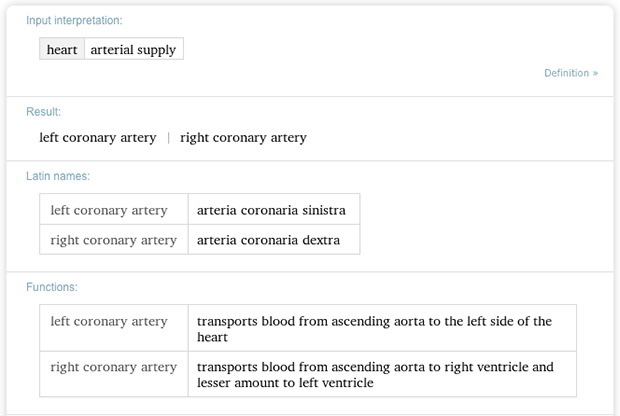
Compare a couple of large vessels of the cardiovascular system just as easily.
Aorta and inferior vena cava:
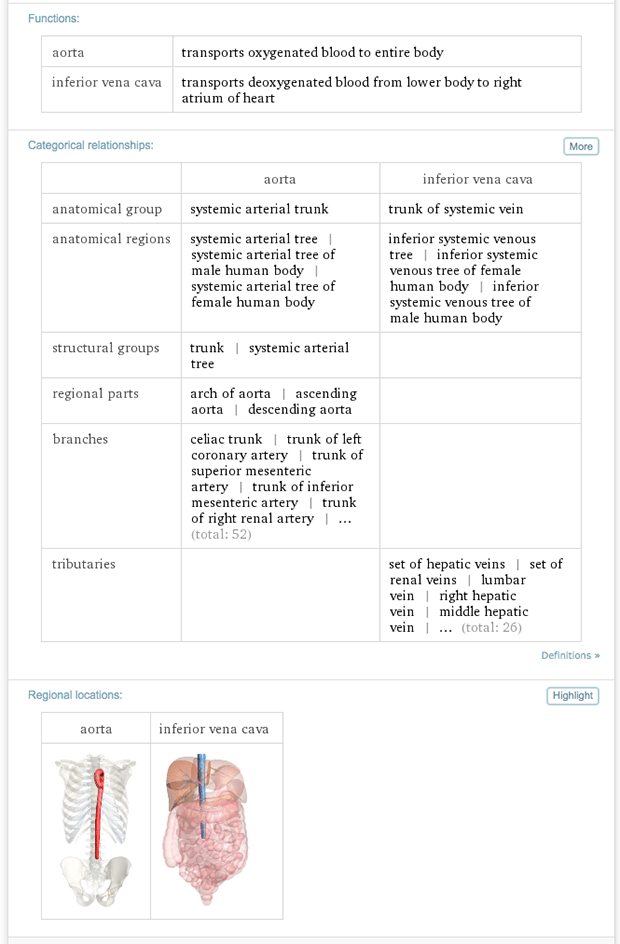
Anatomical data is also available via the Wolfram Language ( their availability in the Wolfram Language automatically means that you can use this functionality in Wolfram Mathematica and Wolfram Cloud ).
Let's look at the locomotor system. If you are a professional gymnast or one who frequently visits a gym, you are probably interested in developing leg muscles. What are these muscles? Wolfram Language can provide information about which muscles are in the legs:
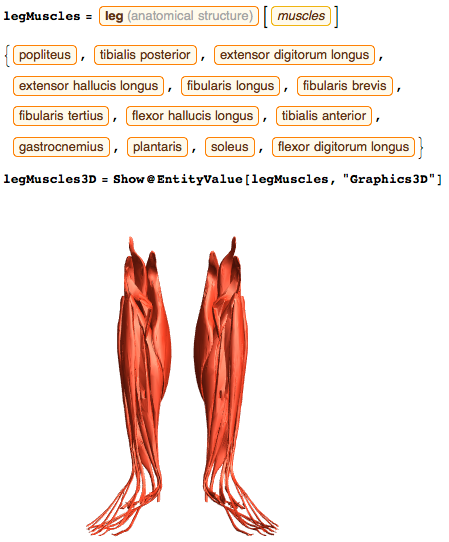
Let us now consider the muscles that are very often involved during exercise - the calf muscles.
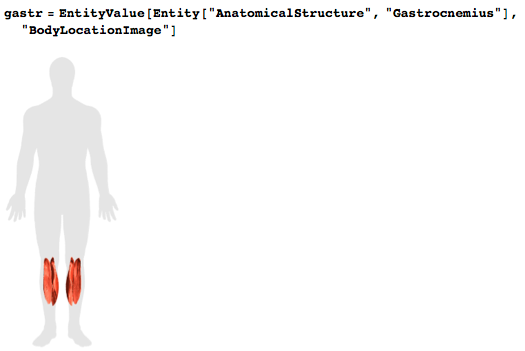
Muscle onset (fixed end) and attachment (movable end):

We now know that the calf muscles are connected to the femur and heel bone. But where exactly are they in the leg?
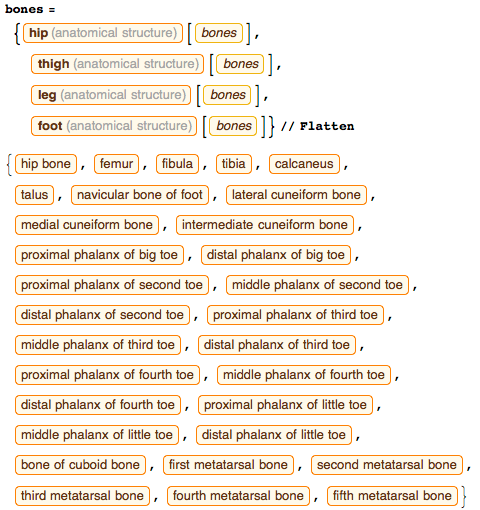
Wow, how many bones! How can we see the forest behind these trees? Let's find out how they are connected to each other:
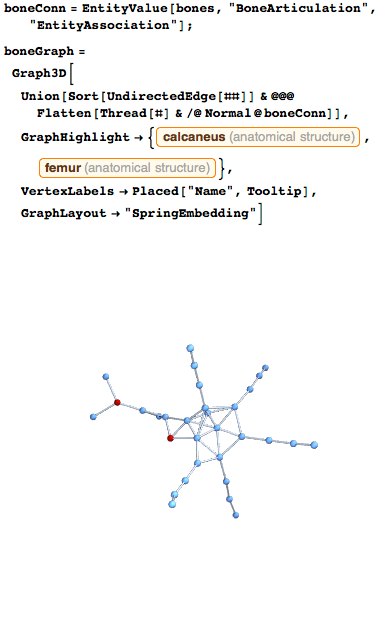
We can see the five fingers on the right, as well as the leg and thigh on the left. Can we find out the names of these bones?
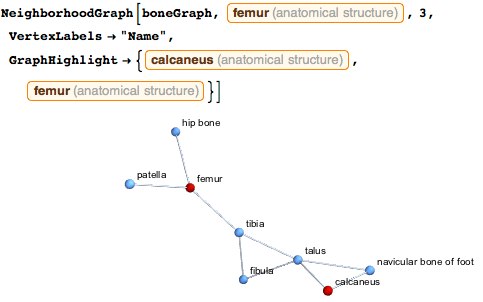
Knowing how bones connect with each other is quite useful. Can we find the heel and femur and look at how they look?
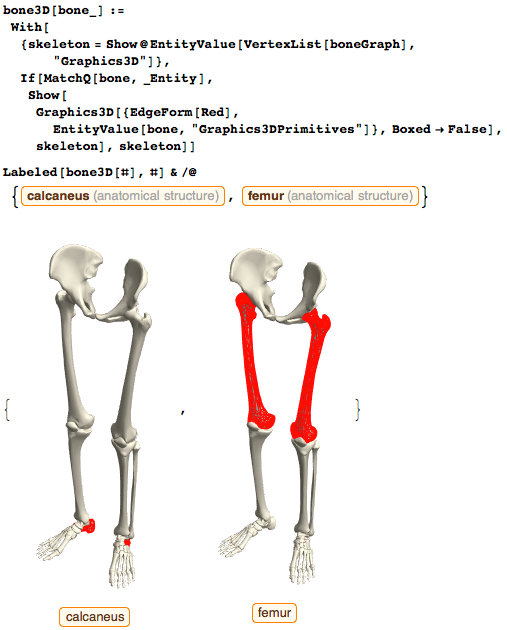
How big is the heel bone? Going even further, you can even find out the volume of the calcaneus:

Let's assume that after an hour of running on a treadmill, which, according to Wolfram | Alpha, burns about 946 calories (at a running speed of about 8 min / mile), you get a signal from your brain that it's time to eat and eat chocolate bar , covering energy expenses.
By pressing "Ctrl" + "=" (in Wolfram Mathematica or Wolfram Cloud) and typing " digestive organs " (organs of the digestive system), we get an idea of the main organs of the digestive system:

We will get a list of the digestive system organs and find out what they are doing:
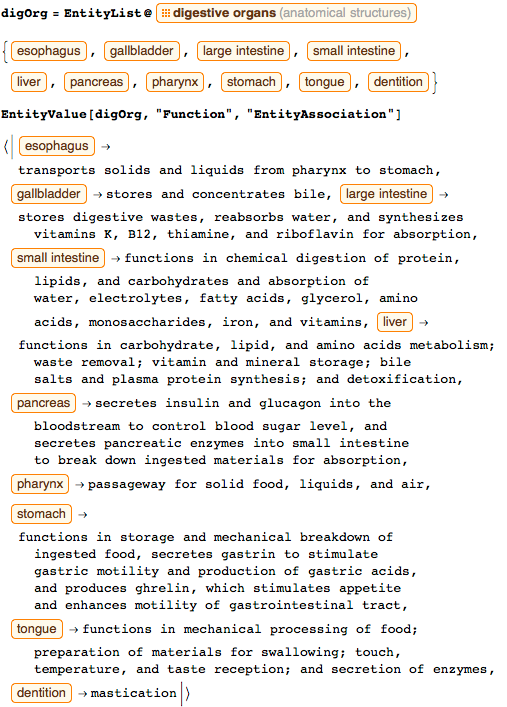
And now we use the Wordcloud function and create a word cloud most commonly used to describe the digestive functions:
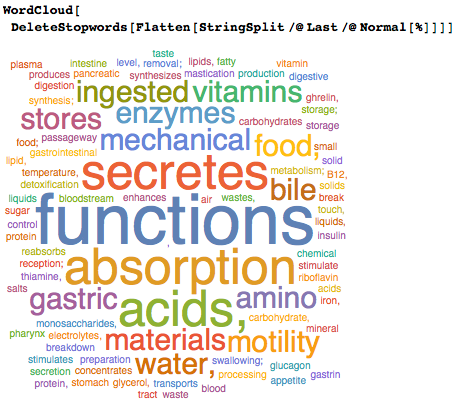
Digestive activity is an unconscious process that is regulated by our autonomic nervous system.
Find out exactly what nerves innervate these organs of digestion:

The vagus nerve and its branches in the nervous system govern the activity of the stomach in the digestive system [1].
After you eat a chocolate bar, your blood glucose level rises. As a result, the pancreas secretes insulin:

This hormone, in particular, signals the nucleus of the hypothalamus that you have eaten, which, in turn, decides that you are full [2]:

How do they affect each other?


Let's illustrate these links:
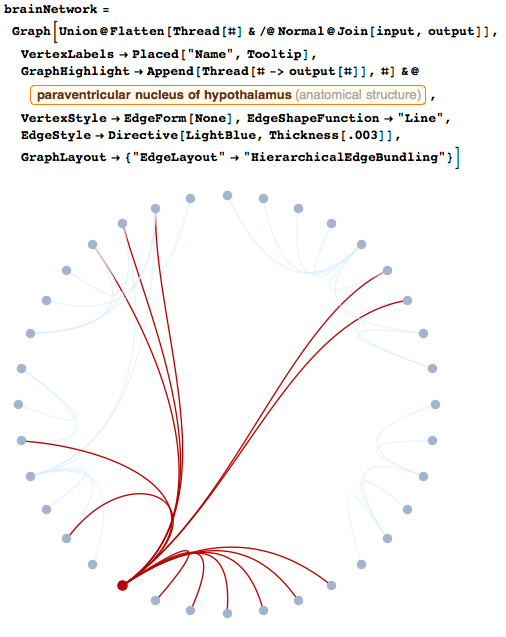
The paraventricular nucleus of the hypothalamus (red) is associated with the regulation of appetite [3], and you can see its connections with the brain stem, which is involved in gastrointestinal functions.
Finally, let's see where this core is located. The paraventricular nucleus of the hypothalamus is located in the left hemisphere of your brain, almost exactly in the center:

It doesn't matter whether anatomy is part of your daily work, or just one of your interests — calculated anatomical data will give you an accessible and deep understanding of how parts of the human body relate to each other. If you want to study this topic in more detail, you can take a look at the documentation on AnatomyData , which presents a sore amount of anatomical concepts and their properties.
Bibliography:
1. GJ Schwartz. “The Role of Gastrointestinal Vagal Afferents in the Control of Food Intake: Current Prospects.” Nutrition 16 no. 10 (2000): 866–873.
2. JK Elmquist, CF Elias, and CB Saper. “From Lesions to Leptin: Hypothalamic Control of Food Intake and Body Weight.” Neuron 22 no. 2. (1999): 221–232.
3. AK Sutton, H. Pei, KH Burnett, MG Myers Jr, CJ Rhodes, and DP Olson. “Neurons of the Paraventricular Hypothalamus Control of Food Intake and Energy Expenditure by Nos1.” Journal of Neuroscience 34 no. 46 (2014): 15306–15318.
Source: https://habr.com/ru/post/271643/
All Articles